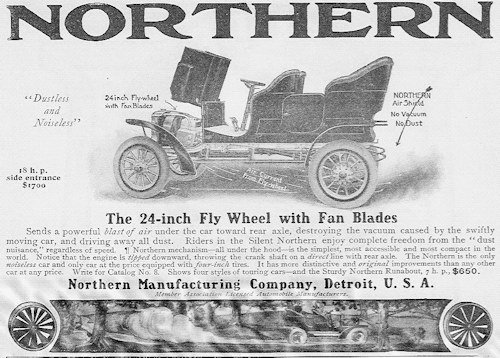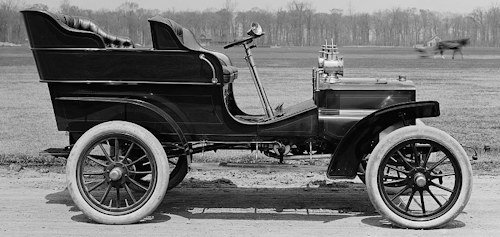Northern Manufacturing Company History

The Northern Manufacturing Company, was an early American car manufacturer, The brand name was Northern.
History
The Northern Manufacturing Company, which became the Northern Motor Car Company in 1906, was an early American automaker. Two of the country's finest automotive and engine manufacturers, Jonathan Dixon Maxwell and Charles Brady King, have been involved in the company. Innovative solutions were used in the automobiles.
A group of Detroit investors around industrialist William A. Barbour and Cadillac William E. Metzger financed the company. Barbour owned the Detroit Stove Works, which was considered the largest oven manufacturer in the world. At Metzger's recommendation, Barbour contracted Jonathan D. Maxwell as plant manager and design engineer. He was also responsible for the first Northern, a car that as "better Oldsmobile Curved Dash" was designed and finally had many technically similar solutions. It was also marketed as Silent Northern in 1902 and 1903 a name that was later used occasionally for the larger two-cylinder models. Maxwell turns Charles B. King took as chief engineer in the company.
In the early summer of 1903, Northern Manufacturing was incorporated into the Association of Licensed Automobile Manufacturers (ALAM) and thus a licensee of the Selden patent. In 1904, Maxwell left the company to start with Benjamin Briscoe the Maxwell-Briscoe Motor Company. His successor as chief engineer was Charles King.
1906 was a reorganization as Northern Motor Car Company. The continued success allowed it to 1907 in Port Huron (Michigan) to take a second plant in operation, only the two-cylinder car Type C produced. Single-cylinder and the new four-cylinder were still manufactured in Detroit.
In 1908, a complex and well-prepared series of acquisitions occurred. The impetus was given to Walter E. Flanders, who wanted to set up a car production after the Ford of developed using his manufacturing method. Affected was initially mentioned the Wayne Automobile Company in Detroit, which was acquired in June by the bodywork contractor Byron Everitt; shortly thereafter he brought Flanders to it. Wayne was already one of the major manufacturers with about 600 vehicles produced in the previous year.
Regardless, William Metzger now separated from Cadillac and acquired the majority of Northern. About this time Charles King left the company. On August 4, 1908, the Wayne Automobile Company was reorganized as Everitt-Butcher-Flanders Company (EMF).
In October 1908, EMF took over the Northern Motor Car Company this acquisition took place only in 1909. EMF had its headquarters in the former Wayne facilities at the Piquette Street ‘earlier in the immediate vicinity of Flanders workplace, Ford's assembly plant for the Model T. addition, the Northern plants in Detroit and Port Huron were also used. The brands Northern and Wayne were set in 1908. The new owners Everitt, Metzger and Flanders formed a team that established further car brands after EMF.
The single-cylinder car was the only model of the manufacturer at the market launch. Jonathan Maxwell is regarded as the designer of the single-cylinder engine in the Oldsmobile Curved Dash and incorporated his experience with this successful model. He succeeded in establishing the Northern brand with his design and laid the foundation for the reputation of the company. The vehicle, often referred to as Northern Runabout in advertising, was a carefully constructed automobile with both conventional and innovative detail solutions. So were the built under the driver's seat engine, the two-speed planetary gear with reverse gear and a single, centrally located to the rear axle drive chain typical of such runabouts. It was still steered with a lever. Design features were chassis side rails in the form of long leaf springs, as they had already been used in Curved Dash, and a subframe that carried the body. The attachment to the chassis was carried out by means of a Northern patented device at only four points. Northern promised itself of this construction a higher ride comfort.
The company attached great importance to simplifying vehicle operation. While Charles King took radical paths with the larger models, approaches in this direction can already be found on the runabout. They are first documented from 1905, but they may have been used earlier by Maxwell.
From 1905 a second, rear-facing seat was available. Other body styles do not seem to have existed. The vehicle was offered consecutively as 5 HP, 6½ HP, 7 HP and Model B; 6 HP In the course of the model maintenance the wheelbase grew from 68 to 70 and finally to 88 inches (1727, 1778 and 2235 mm). Similar to Ford later, the Northern Manufacturing Company was able to offer its product more cheaply over time. The price dropped from US $ 800, - to US $ 750, and finally US $ 650, A Curved Dash cost US $ 650, - in most years of production. Oldsmobile customers also benefited from the best distribution network of this time. The single-cylinder models remained consistent and without significant changes in the program. Depending on the source, production ended in 1908.
Under Charles King's responsibility, larger and more modern two- and four-cylinder models were built parallel to the runabout. The introduction of the 15 HP (announced as 12 HP) took place in 1904 for the model year 1905. The two-cylinder remained until the dissolution of the company in the program. Their peculiarities included the remarkably early introduction of steering wheels, cardan drive, left-hand drive and the possible first use of a three-point hitch of the engine in the chassis. Due to the rearwardly inclined position of the engine better power transmission was achieved on the prop shaft. At least for early two-cylinder models like the 15 HP strange device is used, which blows the road dust under the vehicle to the rear and thus keep away from the passengers. For this purpose, the engine received a particularly large flywheel, which not only contributed to smoother running, but should also take over the task of a blower. The rear side was shaped as a ventilator disk.
The two-cylinder models are among the first automobiles in which the engine and transmission were flanged together; Usually both components were then mounted separately in the chassis and connected by a shaft. Alternatively, there were also blocked with the transmission rear axles; this solution was used by Northern in the four-cylinder models.
King sought to further simplify vehicle operation in these larger models. Both the two- and four-cylinder cars came out without the usual shift and handbrake levers on the outside of the vehicle. They were accelerated and braked with a combined hand lever on the steering column. For the auxiliary brake and the reverse gear, there was at least in the models K and L, a foot pedal. The clutch operation in the two-cylinder is unclear. These vehicles had planetary gears, so that a similar solution as the Ford Model T is obvious. It seems that in the Model C limousine of 1908 all controls could be placed on the steering column.
The four-cylinder were luxury-class vehicles, with which the product range was extended. They received conventional three-speed manual transmission. An air-actuated clutch must have been a great relief to the driver; the former devices were considered to be difficult to use and needed a lot of power. Moreover, these Northern clutches did not have to be readjusted. There was also a pneumatically operated brake that was operated "interactively" with the throttle (by hand) and a compressor to inflate the tires. The pneumatics was based on patents of King. [4] The motor was a mechanical ratchet started instead of a crank occasion.
From the factory, only the two-cylinder models offered commercial vehicle versions. Discloses a closed van, from 1906 to 1908 as Northern 18 HP as well as the successor to Model C was sold.
The Swedish vehicle and rolling stock manufacturer AB Södertälje Verkstäder in Södertälje produced from 1902 to 1906 a license version of the Silent Northern under the brand name North. These vehicles had an additional bench on which the passengers sat with their backs to the direction of travel. Previously, the company had manufactured the Helios.

Technical
-
Northern Model overview (1902-1909)
model
year
engine
Displacement
c.i. / cm³Performance
Wheelbase
inches / mmbody
Prices
US $Silent Northern 5 HP
1902-03
1 sv
5 HP
68/1727
runabout
800, -
6½ HP
1904
1 sv
6½ HP
68/1727
67/1702Runabout, 2 pl.
750, -
12 hp
1904
2 sv
boxers12 hp
Tonneau
1500, -
15 HP
1904
2 sv
boxers15 bhp
88/2235
Touring , 5 Pl.
1500, -
15 HP
1904
2 sv
boxers15 bhp
88/2235
Tonneau, 5 Pl.
1500, -
1700, -7 HP
1905
1 sv
106.3 / 1744
7 HP
70/1778
Runabout, 2 pl.
650, -
17 HP
1905
2 sv
boxers17 HP
100/2540
Touring, 5 Pl.
1700, -
17 HP
1905
2 sv
boxers17 HP
102/2591
Chauffeur Lim. , 5 Pl.
2500, -
18 HP
1905
2 sv
boxers18 HP
88/2235
Runabout, 2 pl.
1500, -
7 HP
Type A [25]1906
1 sv
106.3 / 1744
7 HP
70/1778
Runabout, 2 pl.
650, -
20 HP
Type C1906
2 sv
boxers249.5 / 4088
20 HP
88/2235
100/2540
106/2692Runabout, 2 pl.
1650, -
20 HP
Type C1906
2 sv
boxers249.5 / 4088
20 HP
106/2692
Touring, 5 Pl.
800, -
20 HP
Type C1906
2 sv
boxers249.5 / 4088
20 HP
106/2692
Chauffeur Lim., 4/5 Pl.
2800, -
20 HP
Type C1906
2 sv
boxers249.5 / 4088
20 HP
106/2692
Delivery Van
1200 l1600, -
30 HP
Type K1906
4 sv
318.1 / 5313
30 hp
112/2844
Touring, 5 Pl.
3000, -
7 HP
Type B1907
1 sv
106.3 / 1744
7 HP
70/1778
Runabout, 2 pl.
650, -
20 HP
Type C1907
2 sv
boxers249.5 / 4088
20 HP
88/2235
Runabout, 2 pl.
1600, -
20 HP
Type C1907
2 sv
boxers249.5 / 4088
20 HP
100/2540
Touring, 5 Pl.
1700, -
20 HP
Type C1907
2 sv
boxers249.5 / 4088
20 HP
106/2692
Touring, 5 Pl.
1800, -
20 HP
Type C1907
2 sv
boxers249.5 / 4088
20 HP
106/2692
Chauffeur Lim., 5 Pl.
3000, -
20 HP
Type C1907
2 sv
boxers249.5 / 4088
20 HP
106/2692
Delivery Van
1200 lb1600, -
50 HP
Type L1907
4 sv
432.0 / 7079
50 HP
119/3023
Runabout, 2 pl.
3500, -
50 HP
Type L1907
4 sv
432.0 / 7079
50 HP
119/3023
Touring, 6 Pl.
3500, -
50 HP
Type L1907
4 sv
432.0 / 7079
50 HP
119/3023
Chauffeur Lim., 6 Pl.
4500, -
7 HP
Type B1908
1 sv
106.3 / 1744
7 HP
90/2286
runabout
650, -
24 HP
Type C1908
2 sv
boxers261.4 / 4283
24 hp
100/2540
Roadster
1600, -
24 HP
Type C1908
2 sv
boxers261.4 / 4283
24 hp
106/2692
Touring
1600, -
24 HP
Type C1908
2 sv
boxers261.4 / 4283
24 hp
106/2692
Chauffeur-Lim.
2800, -
24 HP
Type C1908
2 sv
boxers261.4 / 4283
24 hp
106/2692
Delivery Van
1200 lb1600, -
40 HP
Type L1908
4 sv
392.7 / 6435
40 HP
119/3023
Roadster, 2 Pl.
3500, -
40 HP
Type L1908
4 sv
392.7 / 6435
40 HP
119/3023
Touring, 7 Pl. :Tonneau
3500, -


